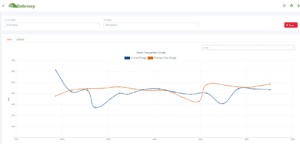Get a 24 hour weather forecast
Efficient milk production from grass-fed cows is a significant challenge for dairy farmers this Spring according to Philip O’Connor, Head of Farm Supports, ifac. However, with careful management and tactical feeding practices, it is possible to optimise milk yields while maximising the utilisation of available resources.
In this technical advice article, Philip explores the financial implications of leaving milk behind and the benefits of supplementing with concentrates, to help achieve peak milk production.
The consequences of failing to achieve peak milk production are significant. For every litre of peak milk not attained, there’s a potential loss of 220 litres over the entire lactation period.
| Drop in Litres/Cow for Peak Milk | 2 Litres |
| Impact of drop over entire lactation | 440 Litre Reduction |
| Financial impact on 100 cow herd | €19,800 |
Consider this, a 2-litre shortfall during peak production translates to a staggering 440-litre loss per cow. At an average milk price (including solids) of 45 cents per litre this could amount to €198 per cow. For a herd of 100 cows, the potential loss increases to €19,800.
Shift the Focus to Future Opportunities
While it’s natural for farmers to want to recover Spring 2024 expenses and tighten budgets, dwelling on past costs can hinder future profitability. These costs are now historical. The spotlight shifts to maximising milk yield for enhanced profitability in the coming month, underlining the importance of sustaining profitable milk yields moving forward. Cutting corners on key inputs to offset previous expenditure can compromise productivity and therefore profitability. Now is not the time to cut back.
The Solution: Maximising Peak Milk Yield
To effectively address this challenge, dairy farmers must focus on two critical areas: grassland management and tactical feeding practices.
1.Know Your Numbers
One of the first steps towards maximising milk profits is knowing where you stand in terms of your current milk supply details. Are you behind on last year’s figures? Chances are, the answer is yes, especially considering the adverse weather conditions experienced by dairy farmers this spring. By logging onto the Gateway platform, or MYMILK app, farmers can access detailed lactation curves for Year-to-Date 2024 and compare these figures to the same time period in 2023. This comparative analysis provides insights into performance trends, enabling more informed decision-making.

Chart 1: Comparison of Milk Supply for April in 1st 2024 vs April in 30th 2024
2.Grassland Management
Grass has always been and will remain the most economical feed for milk production. Farmers must prioritise maximising the utilisation of this invaluable resource. Efficient grassland management involves rotational grazing, grazing the correct covers, fertiliser planning, soil fertility management and monitoring pasture growth, to ensure optimal grazing conditions for the herd. It is vital that farmers get in control of their grass now to ensure the correct pre-grazing covers. Failure to take this action now will impact milk solid production over the coming weeks and year.
3.Tactical Feeding Practices:
Supplementing cows with concentrates during peak milk production is a proven strategy to maximise yields, alongside good grassland management practices. For farmers currently feeding 2kgs of concentrates, feeding an additional 2kg per cow per day can significantly enhance peak milk production. Let’s delve into the financial implications:
There is an economic response to feeding concentrates at current feed and milk prices.
The first two additional kgs of concentrates fed will return a 2.3 ltrs of additional milk. Taking a feed price of 37 cent/kg and a milk price (including solids) of 45 c/l that’s a 1.4:1 ROI. This economic return is more evident in the months of April and May, when farmers strive to correct grass quality and replenish silage reserves.
| Feed Price | Milk Price |
| 37 cents per Kg | 45c/l |
| Daily Economic Return of 1.15: 1 | |
By embracing tactical feeding practices over the next 2 to 3 weeks and practising efficient grassland management over the grazing season, farmers can unlock the full potential of their herds and maximise profitability. Don’t let valuable milk go to waste – invest in optimising peak milk production to lock-in strong profits for your dairy operation.
Remember, in the journey towards peak milk production and sustainable profitability, you don’t have to go it alone – engage with your farm advisors, who are there to support you every step of the way.
Consult your Dairygold Area Sales Manager today for more information.